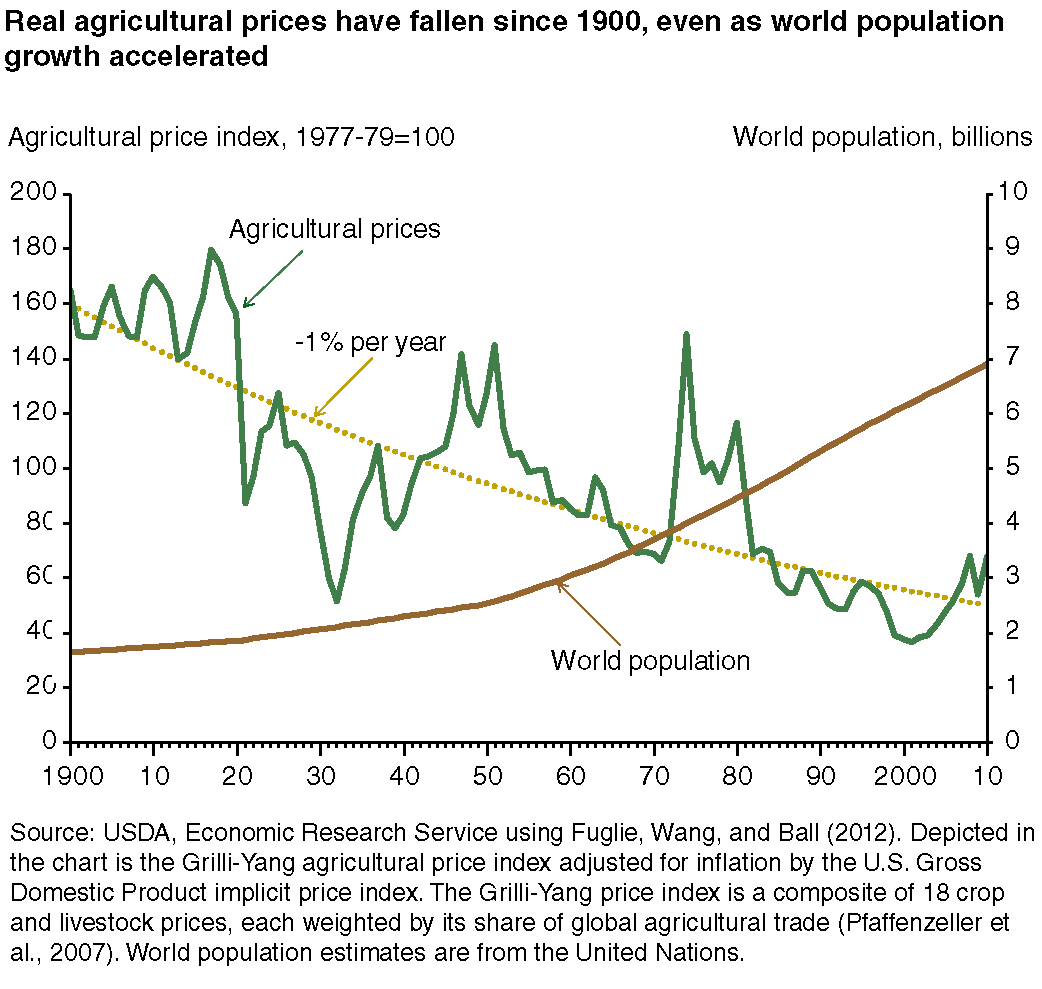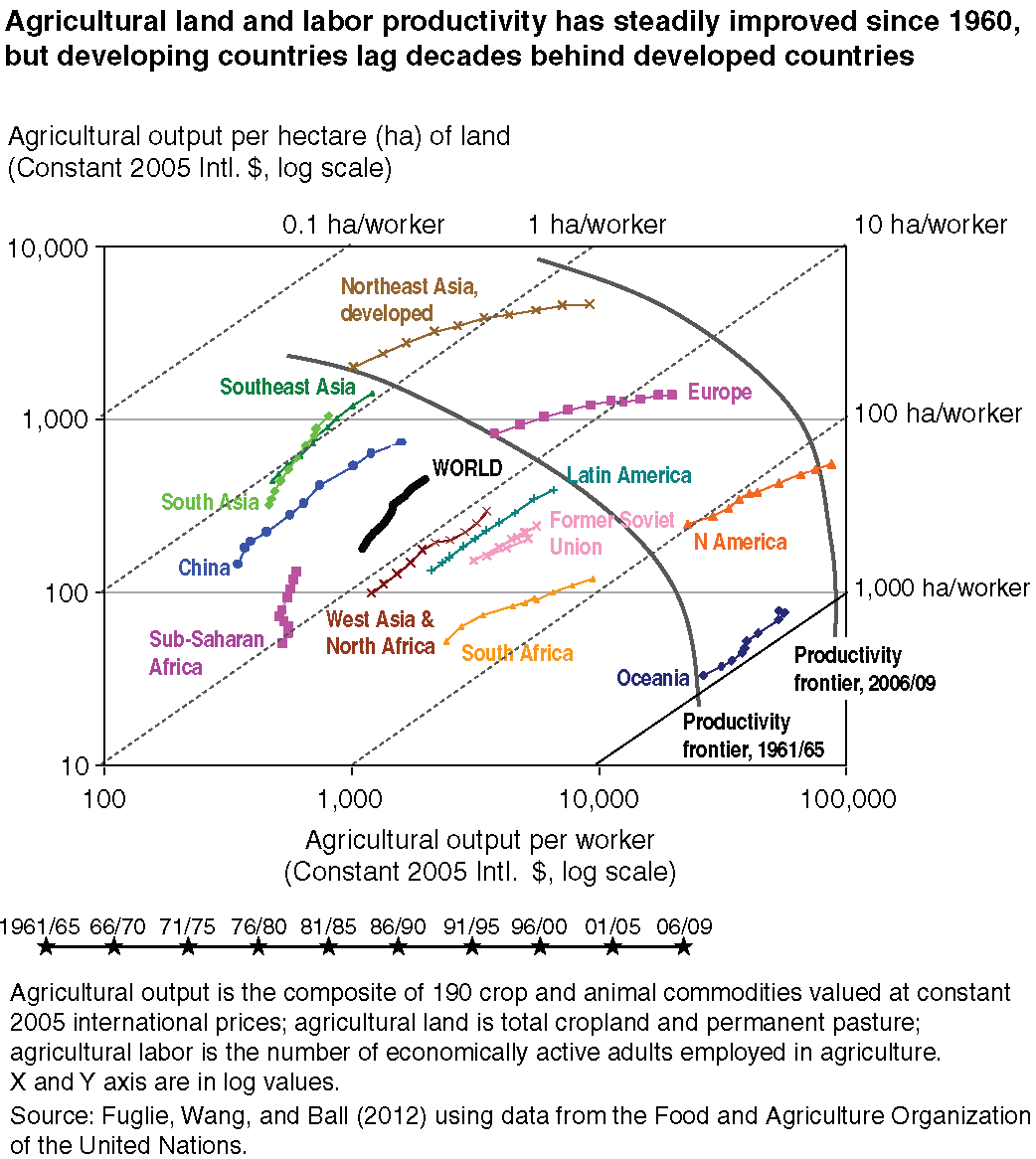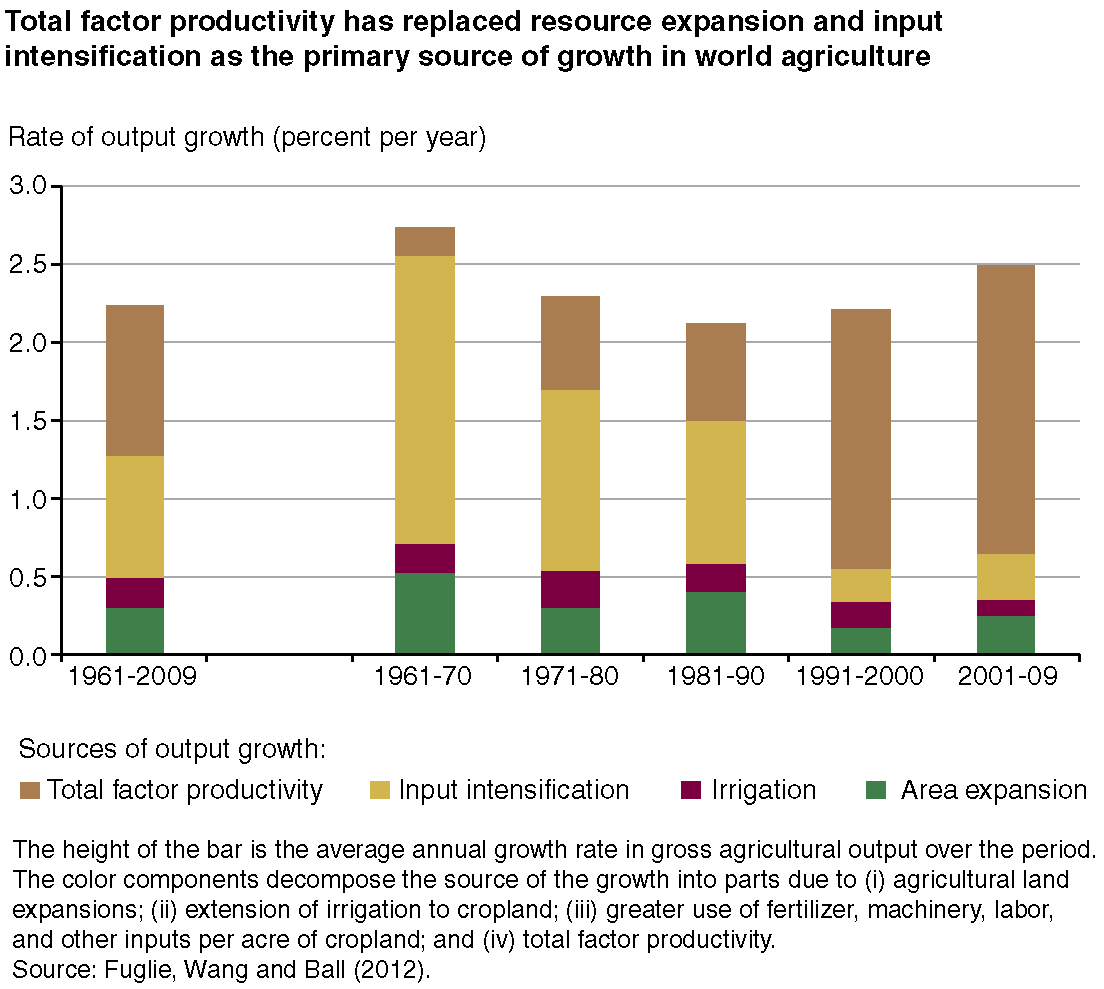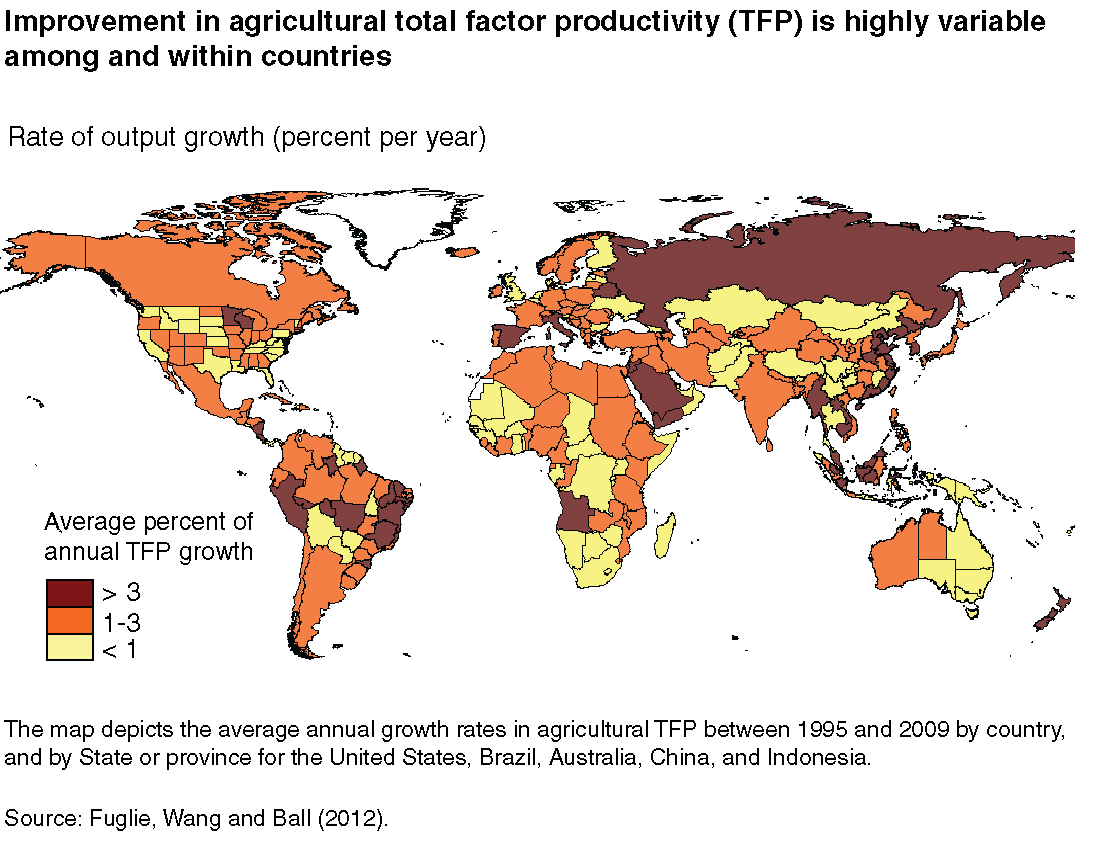New Evidence Points to Robust But Uneven Productivity Growth in Global Agriculture
- by Keith Fuglie and Sun Ling Wang
- 9/20/2012
Highlights
- One important agricultural productivity measure--total factor productivity--is showing rapid growth at the global level led by improved performance in China and Brazil, although the global rate of growth in harvested yield for major grains and oilseeds has slowed.
- Agricultural productivity growth may be slowing in some countries and regions and remains very low in food-insecure Sub-Saharan Africa.
- Policies driving agricultural productivity growth include investments in research and development, economic reforms that strengthen incentives for farmers, rural education and extension, and improved infrastructure.
Improving agricultural productivity has been the world's primary safeguard against a recurring Malthusian crisis--where the needs of a growing population outstrip the ability of man and resources to supply food. Over the past 50 years, global gross agricultural output has more than tripled in volume, and productivity growth in agriculture has enabled food to become more abundant and cheaper. In inflation-adjusted dollars, agricultural prices fell by an average of 1 percent per year between 1900 and 2010, despite an increase in the world's population from 1.7 billion to nearly 7.0 billion over the same period. Nonetheless, food prices have been rising since around 2001. This has renewed concerns about the pace of agricultural productivity growth. If productivity growth slows, then more resources--land, labor, energy, fertilizers, and other inputs--would be needed to meet rising demand, raising the cost of food.
Land and labor productivity in agriculture vary widely across the globe. Over the past 50 years, industrialized countries have consistently achieved the highest levels of agricultural output per worker and per acre of agricultural land. Currently, the developed countries of northeast Asia--Japan, South Korea, and Taiwan--have the world's highest yields (gross output of crops and livestock per hectare of land) while North America (the United States and Canada) and Oceania (Australia and New Zealand) have the highest output per agricultural worker. Developing countries lag far behind these productivity measures but have narrowed the gap in recent decades. Southeast Asia, China, and Latin America are now approaching the land and labor productivity levels achieved by today's industrialized nations in the 1960s.
Growth in Agricultural Total Factor Productivity
Most of the gains in land and labor productivity over the last five decades came from more intensive use of other inputs, such as fertilizers, machinery, and irrigation water. Total factor productivity (TFP) provides a broader concept of agricultural productivity than measures that compare output to just one input, like land or labor. To estimate TFP, researchers total the land, labor, capital, and material inputs used in agriculture and compare growth in total inputs with growth in total output of crop and livestock products. If total output grows faster than total inputs, total factor productivity ('factor' = input) has improved. TFP, therefore, encompasses the average productivity of all inputs employed in the production of all crop and livestock commodities. TFP, however, does not account for agriculture's effects on the environment, such as nutrient runoff into water bodies or greenhouse gas emissions.
Global agricultural output growth has remained remarkably consistent over the past five decades--2.7 percent per year in the 1960s and between 2.1 and 2.5 percent average annual growth in each decade that followed. Growth in agricultural yield (total output per hectare of agricultural land) has mirrored growth trends in output, remaining fairly steady at about 2.1 percent per year over the past 50 years. The growth rate in cereal yield per area harvested, however, showed signs of slowing after 1990. One reason the decline in area harvested yield is not reflected in total agricultural yield is because of land-use intensification. More double cropping and less idled or fallow cropland means more harvests in a year, on average, per hectare of cropland. This can keep cropland productivity rising even if yield per harvest is stagnant. The decline in cereal yield growth was also offset by productivity improvements elsewhere--rising yield growth in other commodities, more meat and milk output per animal, acre of pasture, and pound of feed--to keep total output per hectare of agricultural land rising at historical rates.
However, focusing on yield change does not distinguish between the effects of input intensification (more fertilizer, labor, or capital per acre) and technological change. TFP is a better measure of technological change in agriculture because it captures a broad set of productivity improvements, including those that save other agricultural resources in addition to land. Moreover, it does not count as productivity growth simple substitution between inputs (substituting fertilizer for land or machinery for labor, for example). Recent research findings show that the average rate of TFP change in global agriculture rose significantly over the past half century. The growth rate for aggregate agricultural inputs, meanwhile, fell steadily. Over these 50 years, growth in global agriculture shifted from being primarily resource driven to productivity driven.
The share of global output growth in agriculture attributable to increased use of inputs (in terms of growth in land and water and intensification of other inputs per unit of land) and to TFP has shifted over time. Between 1961 and 2009, about 60 percent of the tripling in global agricultural output was due to increases in input use, implying that improvements in TFP accounted for the other 40 percent. TFP's share of output growth, however, grew over time, and by the most recent decade (2001-09), TFP accounted for three-fourths of the growth in global agricultural production. The rate of expansion in use of natural resources (land and water) has slowed slightly over time while the rate of growth in input intensification has fallen sharply. As such, the source of increase in agricultural yield has shifted markedly from input intensification to improvement in TFP.
Where Agricultural Productivity Is Growing and Why
The trends in agricultural output and TFP growth are hardly uniform across the globe, but three general patterns are evident:
- Developed countries. Total resources used in developed country agriculture have been falling since about 1980. TFP growth has offset the declining resource base to keep output growing. TFP growth appears to have remained robust overall but has slowed in some countries, including Australia and the United Kingdom.
- Developing countries. TFP growth in developing countries doubled from less than 1 percent per year in 1960-90 to over 2 percent per year in 1991-2009. Input growth slowed in each decade but is still expanding enough to keep output growing at over 3 percent per year for each of the last three decades. China and Brazil sustained exceptionally high TFP growth over the past two decades. Several other developing regions, including Southeast Asia, North Africa, and Latin America, also had relatively high TFP growth in the 1990s and 2000s. In Sub-Saharan Africa, however, TFP growth was below 1 percent per year over the same period.
- Transition countries. The dissolution of the Soviet Union in 1991 imparted a major shock to agriculture in countries of the former Soviet Bloc. As these countries made the transition from centrally planned to market-oriented economies, agricultural resources and output contracted. Productivity growth, which was practically nonexistent during the Soviet era, began taking off after 2001. As a result, output growth turned positive and began to recover lost production. By 2009, however, gross agricultural output was still below Soviet-era levels except in Central Asia and Caucasia.
New research provides estimates of agricultural TFP growth not only for individual countries but for the various states and provinces within large countries, namely, China, the United States, Brazil, Australia, and Indonesia. Findings show that productivity varies widely among and within countries. In China, TFP growth is strong in coastal areas but less so in the interior. Brazil has robust TFP growth in coastal areas and in some parts of the interior, such as Mato Grosso in the Cerrado, now the main soybean- and cotton-producing state in the country. In Indonesia, productivity growth is concentrated in the western and northern regions of the country--Sumatra, Kalimantan, and Sulawesi especially--where production of export commodities like palm oil and cocoa is expanding rapidly. In Java and the eastern provinces, TFP growth is low or stagnant. This is a sharp departure from the 1970s and 1980s, when the 'Green Revolution' disproportionately benefitted irrigated rice production, which is especially important in Java. In the United States, productivity growth is moderately strong in the Corn Belt and Lake States but low in the Plains States, Appalachia, and major horticultural States of California and Florida. While Australian 'broadacre' (dryland) agricultural TFP is stagnant nationally, this primarily affects eastern and southern portions of the country.
Sub-Saharan Africa faces perhaps the biggest challenge in achieving sustained, long-term productivity growth in agriculture. It is also projected to have the world's highest population growth rates in coming decades. While a few countries in the region appear to have raised their agricultural TFP growth to over 2 percent per year, others (like Angola) are simply recovering from earlier decades when their agricultural sectors suffered from the effects of war. Raising agricultural productivity growth in Sub-Saharan Africa will likely require significantly higher public and private investments, especially in agricultural research and extension, as well as policy reforms to strengthen incentives for farmers.
Perhaps the single, most important factor separating countries that have successfully sustained long-term productivity growth in agriculture from those that have not is their capacity for agricultural R&D. Countries with national research systems capable of producing a steady stream of new technologies suitable for local farming systems generally achieve higher growth rates in agricultural TFP. Empirical-based results demonstrate the role of local (national or provincial) R&D in capturing 'technology spillovers'--technologies developed elsewhere and adapted for local use. Being actively engaged with foreign or international research institutions significantly raises returns to national agricultural research.
Recent research has identified a number of other factors that account for cross-country differences in agricultural TFP. Improvements in what can broadly be characterized as the 'enabling environment' have encouraged the adoption of new technologies and practices by some countries; these include policies that improve economic incentives for producers, strengthen rural education and agricultural extension services, and improve rural infrastructure and access to markets. At the same time, economically disruptive 'shocks,' such as armed conflict and human or animal diseases (HIV/AIDS in Africa and avian flu in Asia), have stunted agricultural productivity in some countries. Having a more favorable enabling environment complements but does not substitute for R&D. Improving both of these factors increases the likelihood of returns to public investments in agricultural R&D.
This article is drawn from:
- Productivity Growth in Agriculture: An International Perspective. (2012). CAB International, Oxfordshire, UK. Productivity Growth in Agriculture: An International Perspective, by Keith O. Fuglie, Sun Ling Wang, and V. Eldon Ball (eds.), CAB International, Oxfordshire, UK, 2012..
You may also like:
- Agricultural Productivity in the United States. (n.d.). U.S. Department of Agriculture, Economic Research Service.





